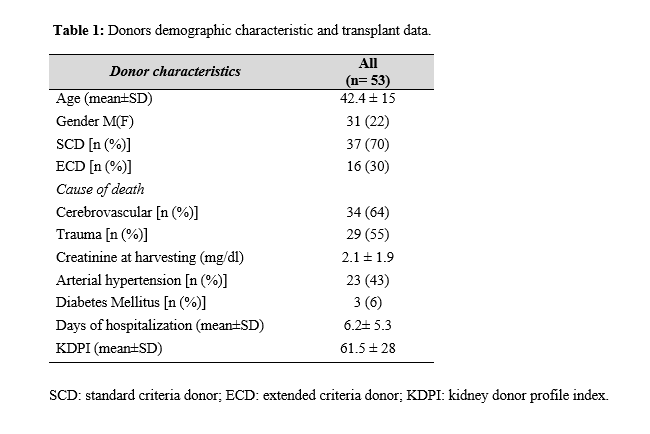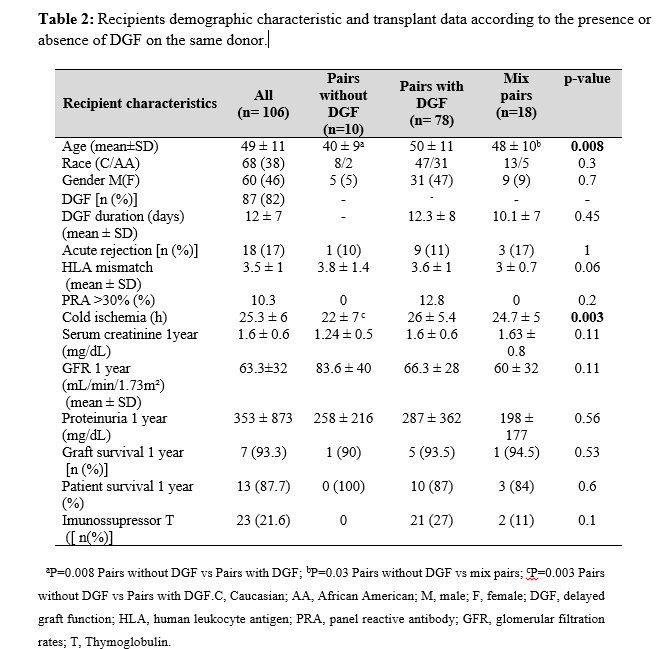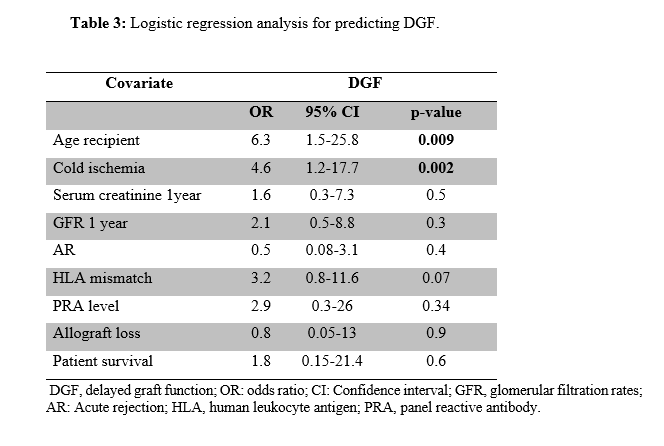Delayed Graft Function in Kidney Transplant: A Pair Analysis
Fernanda S. Gorayeb-Polacchini1,2,3, Heloisa C. Caldas1, Ida M. M. Fernandes-Charpiot1,2, Camila R. Gauch1, Kamilla L. Silva2, Maria Alice S. Ferreira-Baptista1,2, Mario Abbud-Filho1,2,3.
1Laboratory of Immunology and Experimental Transplantation - LITEX, Hospital de Base, FAMERP/FUNFARME, São José do Rio Preto, Brazil; 2Kidney Transplant Unit, Hospital de Base, FAMERP/FUNFARME, São José do Rio Preto, Brazil; 3Nephrology, Urology and Nephrology Institute, São José do Rio Preto, Brazil
Background: There are still many controversies about the factors influencing delayed graft function (DGF) and its impact on kidney transplantation outcome. Methods: We performed a retrospective single-center analysis of the outcomes of both kidneys from the same deceased donor transplanted consecutively into the recipients. One hundred six mate kidneys, transplants performed during the period of 2006 at 2017 were followed during one year post-transplant. We compared outcomes of pairs according to the presence or absence of DGF (DGF+/DGF-; DGF-/DGF-; DGF+/DGF+). Results: The donors were analyzed with characteristic in the table 1.  Comparing pairs, recipient DGF+/DGF+ were older vs DGF-/DGF- and DGF+/DGF- (p = 0.008) and longer cold ischemia time in DGF+/DGF+ compared with DGF-/DGF- (26±5 vs 22±7 hours p = 0.003) (table 2).
Comparing pairs, recipient DGF+/DGF+ were older vs DGF-/DGF- and DGF+/DGF- (p = 0.008) and longer cold ischemia time in DGF+/DGF+ compared with DGF-/DGF- (26±5 vs 22±7 hours p = 0.003) (table 2). Logistic regression showed that only donor age (OR= 6.3, 95% IC= 1.5-25.8, p= 0.009) and cold ischemia (OR= 4.6, 95% IC= 1.2-17.7, p= 0.002) were retained as independent predictors of DGF among donor variables(table3).
Logistic regression showed that only donor age (OR= 6.3, 95% IC= 1.5-25.8, p= 0.009) and cold ischemia (OR= 4.6, 95% IC= 1.2-17.7, p= 0.002) were retained as independent predictors of DGF among donor variables(table3). We did not find difference in relation of acute rejection, one-year kidney function, and patient and allograft survival between the groups. Conclusion: Pairs that developed DGF were associated with older receptors and longer cold ischemic time. Therefore, strategies aimed to reduce the cold ischemic time could reduce risk of delayed graft function.
We did not find difference in relation of acute rejection, one-year kidney function, and patient and allograft survival between the groups. Conclusion: Pairs that developed DGF were associated with older receptors and longer cold ischemic time. Therefore, strategies aimed to reduce the cold ischemic time could reduce risk of delayed graft function.
